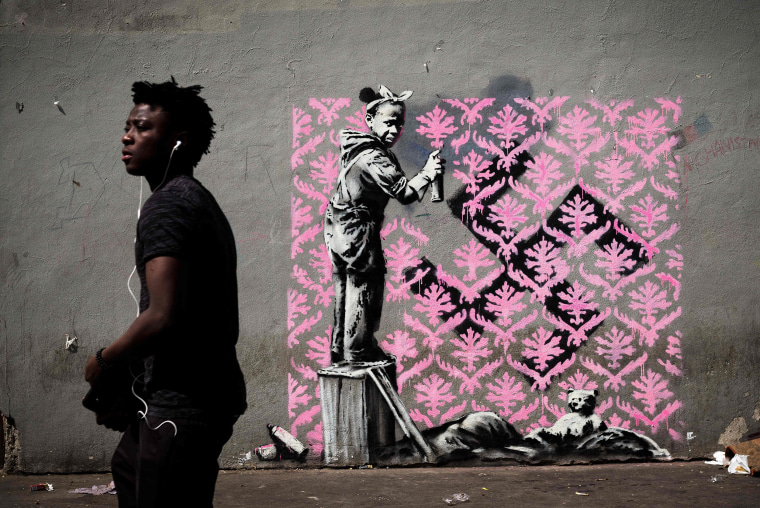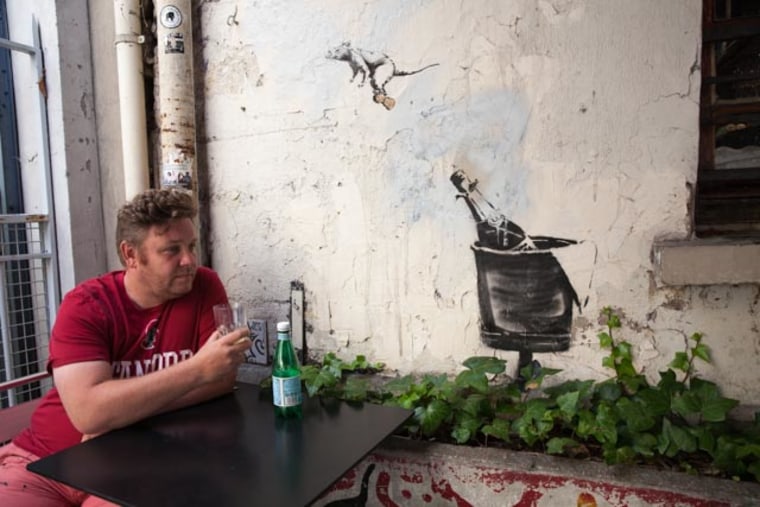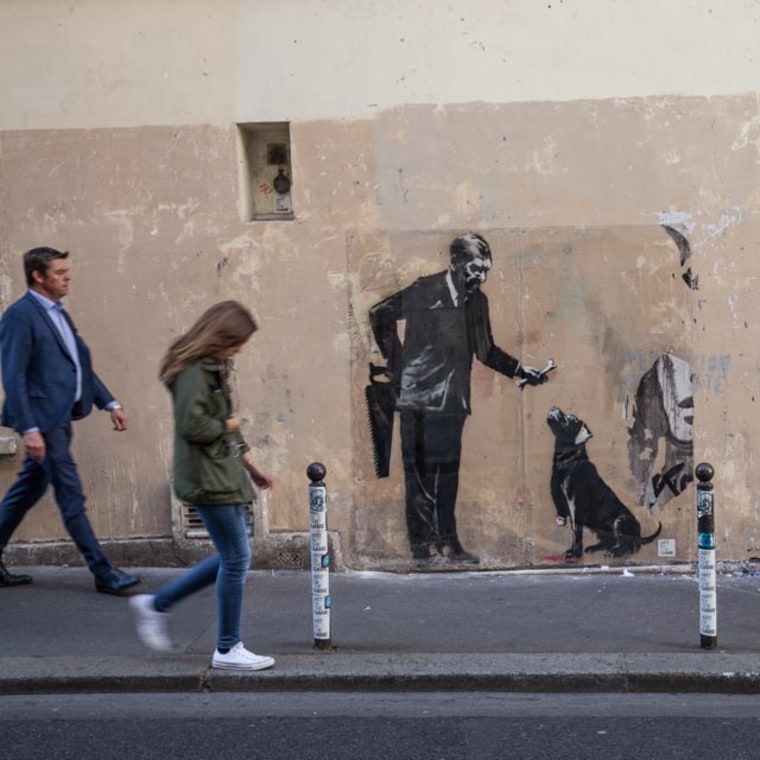PARIS — Banksy painted a live elephant in Los Angeles, unleashed 200 rats in a London gallery, and embellished a portrait of Mother Teresa with the words "moisturize everyday."
Now the elusive street artist has taken aim at Europe's migrant crisis in a series of new works around Paris on the theme of refugees.
The images, rendered in Banksy's trademark somber-toned stencils, began appearing last week and include a depiction of a black girl checking over her shoulder as she paints over a swastika. The pink-flowered wallpaper pattern she uses to hide the swastika borrows from Banksy's 2008 piece, "Go Flock Yourself."
It is not the British graffiti star's first appearance in Paris; he smuggled his updated version of the Mona Lisa, featuring a yellow smiley face, into the Louvre in 2004.
But this time the French capital is grappling with a flow of refugees that authorities have struggled to handle. Officials regularly clear the streets of impromptu migrant camps. Mayor Anne Hidalgo has blamed President Emmanuel Macron's administration for not doing enough to help. On the Italian border, French authorities have been accused of mistreating migrants, including children, even cutting off the soles of their shoes before sending them back to Italy.

At least seven other new works across the city are credited to Banksy. Since the artist maintained his customary silence, nobody can say for sure but he posted a picture of Paris, along with some of the works, on his official Instagram feed.
For Kasia Klon, the location of the girl and the swastika convinced her that it was a genuine Banksy. Klon, who runs Street Art Tours Paris, learned that it appeared near a now-closed center for migrants in northern Paris on June 20, World Refugee Day.
"The whole story started to click," she said. "Banksy is pretty easy to recognize because he has a specific style, and it's in the message that he has with it."
Any doubt in her mind was eliminated when another image appeared near the Sorbonne University depicting a man holding a saw, offering a bone to a three-legged dog.
"It's completely brilliant," Klon said.
Thomas Schmitt, 44, a street artist who goes by Thom Thom, called the work "very dark and funny and logical. How do you feed the dog? You cut off its leg and feed it to him."
Another image that reworked a classic portrait of Napoleon on his horse shrouded in a red robe, prompted speculation that it was a protest against the French government's opposition to Islamic veils in public places.
One of the last images to appear was seen on Monday; a somber figure pasted to a door behind the Bataclan concert hall where terrorists killed 89 people in November 2015.

Other works depicted rats — a Banksy motif — including a snaggle-toothed rodent with a Minnie Mouse bow squatting below a banner for May 1968, a marker for French counter-culture.
Jean-Pierre, a Banksy fan who aimed his phone at a cafe wall in the Marais neighborhood, where a rat sat on a flying cork, dismissed any deep thoughts behind the art.
"It's a rat and it's Paris. It has no meaning," he said.
Outside the Pompidou Center, Matthias Manceaux, 25, gazed up at a masked rat with a menacing grin riding a box-cutter.
Banksy's "rather aggressive" style "touches me personally," Manceaux said. "For me, it's freedom of expression, the freedom to communicate a message."
On the other side of the Seine, architect Sulivan Archambault, 26, considered the man with the saw and his maimed dog.
"There are two types of Banksy," he said, "the political and the other that plays with the emotions of people and their social codes."
Archambault prefers the latter. "I don't like it when artists play politics," he said.
For Schmidt, the image of the girl covering the swastika, painted in an area where many migrants still sleep outside, went too far.
"The swastika was a terrible faux pas," Schmidt said, dismissing any symbolism evoking the government's refugee policies. "A swastika is a swastika," he said.
He apparently wasn't the only one who didn't appreciate the picture; on Monday it was vandalized and covered over in blue paint.

Worried about the same fate befalling the other works attributed to Banksy, Julien Surdeau took to the streets Monday with some friends and fixed plastic covers over four of them. Surdeau, 31, a street artist who goes by #thirstybstd, called it a "big deal" that Banksy would tag in Paris, a city that largely tolerates graffiti, though it is against the law in most places.
"We don't want them to disappear," he said.
Among the pieces now protected is Surdeau's personal favorite: Napoleon in his swirling red cape, which occupies a busy corner of the 19th arrondissement, a neighborhood that is home to many immigrants.
"Everyone can interpret it how they want," Surdeau mused, though for him the meaning for him was distinctly political.
"For me, it's about being led by blind people," he said.

